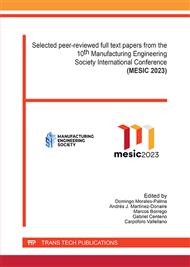[1]
Liao Y, Deschamps F, Loures E de FR, Ramos LFP. Past, present and future of Industry 4.0 - a systematic literature review and research agenda proposal. International Journal of Production Research. 2017 Jun 18;55(12):3609–29.
DOI: 10.1080/00207543.2017.1308576
Google Scholar
[2]
Pereira RM, Szejka AL, Junior OC. Towards an information semantic interoperability in smart manufacturing systems: contributions, limitations and applications. International Journal of Computer Integrated Manufacturing. 2021 Feb 28;0(0):1–18.
DOI: 10.1080/0951192x.2021.1891571
Google Scholar
[3]
Szejka AL, Mas F, Junior OC. Towards Knowledge-Based System to Support Smart Manufacturing Processes in Aerospace Industry Based on Models for Manufacturing (MfM). In: Canciglieri Junior O, Noël F, Rivest L, Bouras A, editors. Product Lifecycle Management Green and Blue Technologies to Support Smart and Sustainable Organizations. Cham: Springer International Publishing; 2022. p.425–37. (IFIP Advances in Information and Communication Technology).
DOI: 10.1007/978-3-030-94399-8_31
Google Scholar
[4]
Mas F, Racero J, Oliva M, Morales-Palma D. A Preliminary Methodological Approach to Models for Manufacturing (MfM). In: Chiabert P, Bouras A, Noël F, Ríos J, editors. Product Lifecycle Management to Support Industry 40. Cham: Springer International Publishing; 2018. p.273–83. (IFIP Advances in Information and Communication Technology).
DOI: 10.1007/978-3-030-01614-2_25
Google Scholar
[5]
IEEE: IEEE Standard Glossary of Software Engineering Terminology. IEEE Std 61012-1990. 1–84 (1990)
DOI: 10.1109/IEEESTD.1990.101064
Google Scholar
[6]
HAASE, P.; VÖLKER, J. Ontology Learning and Reasoning — Dealing with Uncertainty and Inconsistency. (P. C. G. da Costa et al., Eds.) Uncertainty Reasoning for the Semantic Web I. Anais...: Lecture Notes in Computer Science. Berlin,Heidelberg: Springer, 2008.
DOI: 10.1007/978-3-540-89765-1_21
Google Scholar
[7]
JEON, S. M.; SCHUESSLBAUER, S. Digital Twin Application for Production Optimization. 2020 IEEE International Conference on Industrial Engineering and Engineering Management (IEEM). Anais...dez. 2020.
DOI: 10.1109/ieem45057.2020.9309874
Google Scholar
[8]
Park, K.T., Nam, Y.W., Lee, H.S., Im, S.J., Noh, S.D., Son, J.Y., Kim, H., 2019]. Design and implementation of a digital twin application for a connected micro smart factory. Int. J. Comput. Integr. Manuf. 32, 596–614.
DOI: 10.1080/0951192X.2019.1599439
Google Scholar
[9]
SEMERARO, C. et al. Digital twin paradigm: A systematic literature review. Computers in Industry, v. 130, p.103469, 1 set. (2021)
DOI: 10.1016/j.compind.2021.103469
Google Scholar
[10]
STEP Files, Information on: https://www.adobe.com/creativecloud/file-types/image/vector/step-file.html.
Google Scholar
[11]
The STEP File Format - Simply Explained, Information on: https://all3dp.com/2/step-file-format-simply-explained/
Google Scholar
[12]
Ghaffarishahri, S.; Rivest, L.: Feature Recognition for Structural Aerospace Sheet Metal Parts, Computer-Aided Design & Applications, 17(1), 2020, 16-43
DOI: 10.14733/cadaps.2020.16-43
Google Scholar
[13]
F. Mas, J. Racero, M. Oliva, D. Morales-Palma, A Preliminary Methodological Approach to Models for Manufacturing (MfM), in: P. Chiabert, A. Bouras, F. Noël, J. Ríos (Eds.), Product Lifecycle Management to Support Industry 4.0, Springer International Publishing, 2018: p.273–283.
DOI: 10.1007/978-3-030-01614-2_25
Google Scholar
[14]
D. Morales-Palma, M. Oliva, J. Racero, I. Eguia, R. Arista, F. Mas, Metamodels Approach Supporting Models for Manufacturing (MfM) Methodology, in: O. Canciglieri Junior, F. Noël, L. Rivest, A. Bouras (Eds.), Product Lifecycle Management. Green and Blue Technologies to Support Smart and Sustainable Organizations, Springer International Publishing, Cham, 2022: p.398–409.
DOI: 10.1007/978-3-030-94399-8_29
Google Scholar
[15]
F. Mas, J. Racero, M. Oliva, D. Morales-Palma, Preliminary ontology definition for aerospace assembly lines in Airbus using Models for Manufacturing methodology, Procedia Manufacturing. 28 (2019) 207–213.
DOI: 10.1016/j.promfg.2018.12.034
Google Scholar
[16]
W3C: SW - Semantic Web, https://www.w3.org/standards/semanticweb/
Google Scholar
[17]
W3C: SWRL - A Semantic Web Rule Language Combining OWL and RuleML, https://www.w3.org/Submission/SWRL.
Google Scholar
[18]
W3C: OWL - Web Ontology Language, https://www.w3.org/TR/owl2-overview.
Google Scholar



